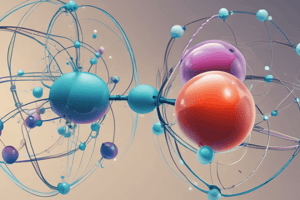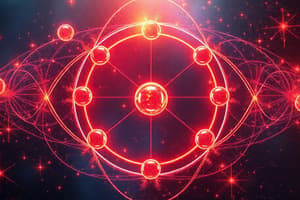Podcast
Questions and Answers
What is the result of an electron dropping from an energy level to the second energy level?
What is the result of an electron dropping from an energy level to the second energy level?
- Visible light is produced (correct)
- Gamma ray is produced
- UV light is produced
- X-ray is produced
What is the term for the distance of an ion's nucleus to its outermost electron?
What is the term for the distance of an ion's nucleus to its outermost electron?
- Ionic radius (correct)
- Non-metallic character
- Metallic character
- Effective nuclear charge
What is the result of increasing the wavelength of light?
What is the result of increasing the wavelength of light?
- Frequency decreases and energy increases
- Frequency and energy decrease (correct)
- Frequency and energy increase
- Frequency increases and energy decreases
What is the condition for a nucleus to be stable?
What is the condition for a nucleus to be stable?
What is the unit of Planck's constant?
What is the unit of Planck's constant?
What is the result of a decrease in wavelength on frequency and energy?
What is the result of a decrease in wavelength on frequency and energy?
What is the principle that states that electrons fill up each suborbital before being placed in a suborbital with another electron?
What is the principle that states that electrons fill up each suborbital before being placed in a suborbital with another electron?
What is the trend for atomic radius down a group in the periodic table?
What is the trend for atomic radius down a group in the periodic table?
What is the relationship between effective nuclear charge (Zeff) and shielding electrons?
What is the relationship between effective nuclear charge (Zeff) and shielding electrons?
What is the trend for metallic character across a period in the periodic table?
What is the trend for metallic character across a period in the periodic table?
Flashcards are hidden until you start studying
Study Notes
Nuclear Stability
- A nucleus is stable when the number of protons is equal to the number of neutrons, or when the sum of protons and neutrons is greater than 82
Effective Nuclear Charge
- Defined as protons minus shielding electrons
- Increases across a period due to more protons per energy level
Atomic Radius
- Defined as the distance of an atom's nucleus to another atom's nucleus divided by 2
- Periodic trend: decreases across a period, increases down a group
Ionic Radius
- Defined as the distance of an ion's nucleus to its outermost electron
- Periodic trend: decreases across a period, increases down a group
Electronegativity
- Defined as an atom's ability to attract and hold electrons
- Periodic trend: increases across a period, decreases down a group
Metallic and Non-Metallic Character
- Metallic Character: defined as how easy it is for a metal to lose an electron
- Non-Metallic Character: defined as how easy it is for a nonmetal to gain an electron
- Periodic trend for Metallic Character: decreases across a period, increases down a group
- Periodic trend for Non-Metallic Character: increases across a period, decreases down a group
Ionization Energy
- Defined as the energy required to remove an electron from an atom
Spectroscopy
- λ (lambda) represents wavelength in meters
- ν (nu) represents frequency of a photon, often in HZ or S^-1
- When wavelength increases, frequency and energy decrease
- When wavelength decreases, frequency and energy increase
- When an electron drops from a higher energy level to the second energy level, visible light is produced
- When an electron drops from a higher energy level to the first energy level, UV light is produced
Orbital Rules
- Aufbau's principle: an electron occupies the lowest-energy orbital that can receive it
- Creepy-bus rule (Hund's rule): electrons fill up each suborbital before being placed in a suborbital with another electron
- F orbitals start with atoms #59 (Pr, Praseodymium) and #91 (Pa, Protactinium)
Isotopes and Atomic Mass
- Mass number: number of protons plus neutrons (P+N)
- Percent Abundance: percentage of atoms of a particular isotope in a natural sample of a pure element
- AMU (Atomic Mass Unit): calculated by weighted average of isotopic masses based on percent abundance
Studying That Suits You
Use AI to generate personalized quizzes and flashcards to suit your learning preferences.



